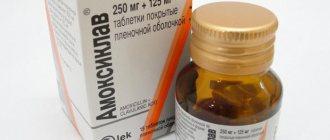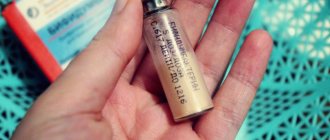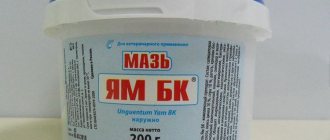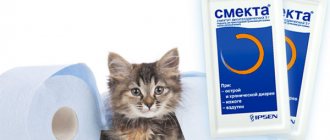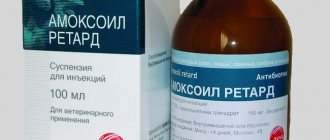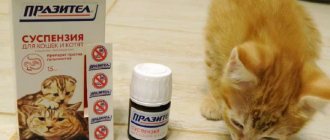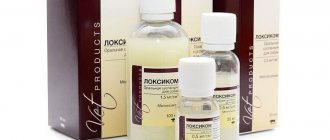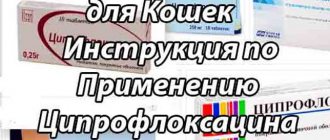When are antihistamines needed and how do they work?
Antihistamines are used to eliminate allergic reactions in cats. Medicines are prescribed after a series of studies and confirmation of the diagnosis. Medicines in this group help eliminate itching, burning, skin rashes and lacrimation. The effect of such drugs is due to the binding of histamine and a decrease in its production.
Antihistamines relieve cats from itching associated with an allergic reaction to something
In some cases, such medications can relieve the cat of edema, which can contribute to the occurrence of anaphylactic reactions that are life-threatening for the pet. In addition, antihistamines reduce the manifestations of the inflammatory process and have a slight calming effect.
In what cases is this group of medications used:
- if symptoms of flea dermatitis occur;
- if you are allergic to medications, household chemicals and food;
- when itching occurs for an unknown reason;
- with atopic dermatitis;
- after an insect bite.
Allergies - causes and signs
Cats and cats can suffer from both seasonal and permanent rhinitis. The antiallergic drug Zodak is suitable for treating cats and even some breeds of dogs that are prone to allergic reactions. The following pathogens can provoke them :
- insect bite (flea, tick, bee, mosquito) on the animal’s nose, ear, paw pads;
- fungi, helminths, viruses and bacteria;
- pollen, herbaceous plants, shrubs;
- change of feed; certain food; food products: poultry, beef, yeast, eggs, fish, fish oil, soy, wheat, dairy, corn, vegetable oils;
- dust, tobacco smoke in the house;
- household chemicals, aerosols, perfumes, shampoo, soap;
- synthetic fabrics;
- tray filler;
- veterinary drugs, medicines;
- fur of other animals;
- rubber and plastic toys.
When a cat is sensitive to one or more of the above allergens, then painful allergy symptoms appear. Zodak helps with all signs of allergies, which manifest themselves in the form of rashes and spots on the skin, debilitating skin itching, scratching until it bleeds, wounds and hair loss, difficulty breathing, swelling of the mucous membranes of the tongue, larynx and suffocation, discharge from the nose and ears, malfunction intestines and vomiting.
Review of antihistamines for cats - table
Claritin belongs to the second generation of antihistamines Lordestin effectively eliminates allergy symptoms Diphenhydramine eliminates anaphylactic reactions Suprastinex belongs to the third generation of antihistamines Zirtek effectively eliminates itching Chloropyramine has a pronounced sedative and antiallergic effect
| Name | Release form | Active ingredient | What generation | Indications | Contraindications | Adverse reactions | Price |
| Diphenhydramine | diphenhydramine | First |
|
|
| From 40 rub. | |
| Chloropyramine | chloropyramine hydrochloride | First |
|
|
| From 79 rub. | |
| Zyrtec | Drops for oral administration | cetirizine dihydrochloride | Second |
|
|
| From 150 rub. |
| Claritin | loratadine | Second |
|
|
| From 190 rub. | |
| Suprastinex | Levocetirizine dihydrochloride | Third |
|
|
| From 259 rub. | |
| Lordestin | desloratadine | Third |
| Individual intolerance. |
| From 296 rub. |
Composition, description, release forms
Zodak drops are sold in pharmacies in small bottles of 20 milliliters. Each milliliter is approximately twenty drops of the drug.
Depending on the doctor’s prescriptions, each mother can estimate how long one bottle will last her.
The medicine is transparent, sometimes with a slight yellowish tint. The active ingredient in it is cetirizine dihydrochloride.
To an uninitiated person who has never suffered from allergies, this name means little, but experts know it well as a drug that quickly gives the patient relief and prevents the development of allergic symptoms in the future.
Among the excipients included in Zodak:
- water;
- glycerol;
- acetic acid;
- propylene glycol (dihydric alcohol).
Many mothers also know about the existence of Zodak syrup and often wonder: why not replace the drops with a sweet syrup that is more pleasant for the baby.
However, it is necessary to strictly follow the doctor’s recommendations, because there is still a difference between the two types of the drug: the concentration of the active substance in the syrup is higher than in the drops.
When writing a prescription, the doctor must take this into account, as well as other features of the drug’s action.
Types of treatment
Advice from veterinarians and rules for using antihistamines:
- Do not exceed the dose of the drug without a doctor's prescription.
- Give the medicine only on an empty stomach, otherwise your pet may vomit.
- It is advisable to mix the tablet with water, as many allergy medications are very bitter.
- It is best to give antihistamines at the same time every day.
- Monitor your pet's reaction. If vomiting or diarrhea occurs, antihistamine treatment should be discontinued.
Treatment of allergies in cats can be local, complex or symptomatic. Most often, several types of treatment procedures are combined with each other.
Local therapy
Topical products include hydrocortisone-based shampoos. If the animal is weakened and unable to lick itself, the doctor may recommend an ointment of a similar composition. At this point, local therapeutic treatment is considered complete. If the expected positive effect does not occur, tablets, drugs for intramuscular and subcutaneous administration are used as part of symptomatic and complex therapy.
Relieving itching
To relieve itching use:
- the already mentioned ointment with hydrocortisone;
- vitamin B7 (introduced into the cat’s body along with omega fatty acids, reduces itching, seborrhea, moisturizes the skin);
- steroids;
- antihistamines.
Important! Treatment for allergies caused by food irritants and allergies caused by blood-sucking insect bites differs in terms of the sequence of actions. If in the first case it is enough to eliminate the irritant and use an antihistamine, then in the second you will have to first get rid of insects and carry out deworming and only after that give the cat anti-allergy medications.
In veterinary medicine, a cat or feline tolerates the same anti-allergenic drugs well as humans. Only the dosage of Zodak will differ; cats should be given in smaller quantities.
Benefits and Applications
In veterinary medicine, a cat or feline tolerates the same anti-allergenic drugs well as humans. Only the dosage of Zodak will differ; cats should be given in smaller quantities.
© shutterstock
The advantages of the drug are undeniable:
- Zodak begins to act 15 minutes after administration.
- Zodak quickly and effectively relieves allergy symptoms.
- Zodak is effective for various types of allergies.
- Zodak affects different stages of an allergic reaction.
- Zodak quickly and significantly improves the animal’s condition.
- Zodak is valid for 24 hours.
- Zodak strengthens the walls of blood vessels.
- Zodak does not cause sedation (apathy and drowsiness).
- Zodak is suitable for cats of different ages.
- Zodak does not contain sugar in its composition.
Doses are calculated according to the instructions for 1 kilogram of pet's weight . A cat or cat can accept a children's Zodak. The dosage should correspond to half the pediatric dose. But it is worth warning that in the case of both a child and an animal, you cannot treat it yourself. After all, cats and cats trust us.
Wrong dose or therapy can lead to big problems. Therefore, the dosage of Zodak for a cat against allergies should be prescribed by a veterinarian. Only a specialist can determine the type of pathogen, the cause and type of allergy, make the correct diagnosis, and also prescribe a specific antihistamine.
© shutterstock
How to use
The bottle is made with safety in mind: to open the cap, you must press it firmly and then unscrew it in the opposite direction to the clockwise direction.
After use, return the lid to its original position, otherwise an inquisitive baby may get to the medicine and cause trouble.
The instructions for using Zodak drops for children recommend dissolving the drug in a small amount of water before use.
Their intake is absolutely independent of food: whether you give it before or after breakfast is not of fundamental importance.
Children are allowed to give Zodak without diluting it with water: just drop it directly into the child’s mouth.
If you made a mistake - you forgot to give your child the medicine at the prescribed time, give him the medicine at the first opportunity.
If you discover that you have made a mistake when it is almost time for your next dose, continue with your schedule, but do not double the dose due to the missed dose - give exactly as much as you usually give at one time.
If you are not sure that you remember the doctor’s recommendations well, read the instructions for using Zodak children’s drops - it indicates the methods of administration.
However, do not change the dosage determined by your pediatrician under any circumstances.
Note to mothers: what is chronic adenoiditis in children and how to treat a child? Let's ask the doctor!
You can learn about the treatment of acute tracheitis in children from this article.
Instructions for the use of Suprastin antihistamine tablets for children are presented in our review article.
How to give your cat a pill correctly
Antihistamines that are used to treat people can also be given to cats, but only after first consulting a doctor. Only a veterinarian can establish an adequate dose and course of therapy depending on the symptoms.
READ Enterosgel how to give medicine to a cat
When the cat had an allergic reaction, she was given a first generation antihistamine. The pet had dermatitis of unknown origin. The whole stomach was bald, there were rashes and severe itching. After taking the medication, the symptoms disappeared, the cat stopped licking itself and scratching the sores. Unfortunately, after stopping the medication, the allergy symptoms returned.
Before giving the cat a pill, he is limited in food for several hours. A hungry animal will not notice the pill hidden in a small piece of boiled meat or cutlet, and thus it will be possible to give it the medicine without any problems. If your pet refuses to eat, then:
- for 5-10 minutes. calm the cat: pet it, play with it;
- they take him in their arms, put him on their knees and squeeze him between them;
- gently unclench their jaws;
- put a pill in the open mouth;
- squeeze the cat's jaws, preventing the cat from getting rid of the drug.
The cat quickly orients itself and swallows the medicine, so you won’t have to keep its jaws closed for long, 1-2 minutes is enough. After the procedure, the animal’s mouth and fur are examined to make sure that the tablet did not fall out or get lost somewhere.
To treat allergies in cats, they use proven remedies, often suitable not only for animals, but also for humans, and therefore are sold in a regular non-veterinary pharmacy. But, before purchasing the drug yourself and giving it to your animal, you need to call the veterinary clinic and ask, for example, whether cats can be given loratadine for allergies or any other drug recommended by the pharmacist (the list of drugs is quite long).
Mexidol injections
Available in two forms - injections and tablets. Injections are the most effective and safe. The drug is prescribed to improve blood circulation, increase the body's endurance (acts as a sedative), and against skin diseases. Injections are used for acute forms of the disease. The estimated dose is 15 mg per 1 kg of weight. Adverse reactions occur only if the animal has an individual intolerance to this antiallergic drug for cats.
For your information! Mexidol should be used with caution if kidney or liver function is impaired.
Omega-3
Omega-3 fatty acids are a supplement that can be beneficial for animals. This is not a medicine, but an additional source of active substances. The drug helps maintain the animal’s coat in proper condition (this is especially true when breeding Scottish cats), prevent the development of dermatitis, and reduce the intensity of aggravated skin diseases.
Important! Give omega-3 regularly, and not just when an allergic reaction occurs.
Available in the form of tablets and syrup. The drug is used to prevent allergies or alleviate their symptoms. Peritol relieves itching, acts as an anticholinergic, antiexudative and sedative. The dosage is selected by the doctor. Zyrtec for cats has a similar effect on the body, the dosage of which is also selected solely on the recommendation of a specialist.
Zyrtec
Clemastine (tavegil)
Relieves runny nose and cough. After taking the drug, the animal stops sneezing and tears stop rolling from the eyes. The positive effect lasts for a long time. To achieve it, it is enough to give the cat 0.5 tablets every 12-24 hours. The drug affects the central nervous system, which is why the animal becomes apathetic, refuses to eat, and often goes to the toilet (loose stools).
Zodak is a 2nd generation antihistamine. It is produced in the form of tablets, drops, syrup and solution for injection. The product begins to act after 15 minutes. after introducing it into the cat’s body, it helps with various types of allergies, is effective for 24 hours, and does not contain sugar. Zodak is suitable for cats of all ages; there is a drug for kittens. The dose depends on weight. The drug blocks the release of histamine, and there are practically no side effects after its use.
Suprastin
Suprastin is an antihistamine used to treat allergies in humans and animals. The dose depends on weight, 0.25 tablets are given for every 5 kg of weight (it cannot be exceeded, sharply negative reactions are possible). The course of treatment depends on the doctor’s recommendation, but usually does not exceed three days.
Note! Suprastin can also be purchased in the form of injections.
Suprastin
Hydroxyzine
The antihistamine calms, suppresses vomiting, relieves pain, and helps the pet breathe as it promotes dilation of the bronchial tubes. To treat an adult cat, it is enough to give her up to 15-20 mg of allergy medication for cats per day.
Diphenhydramine
Often used to get rid of allergies resulting from insect bites. After using the drug, the animal becomes lethargic and sleeps a lot (this is normal). The side effects are the same as with regular diphenhydramine. Diphenhydramine should not be given to kittens, pregnant animals, or lactating cats, or together with medications to lower body temperature. To relieve signs of allergy, it is enough to give an adult animal 2-6 mg of the substance once a day.
Chlorpheniramine
Helps with feline dermatitis and urticaria, but long-term use is prohibited (up to three days in a row). The drug is taken when acute signs of the disease appear. It is administered intramuscularly or orally (before or after meals). Dose - 1-2 ml for intramuscular administration and 2-4 ml for oral administration.
The main condition for successful treatment and complete elimination of allergies is the removal of the allergen.
It is clear that this is not always possible, but if the exact cause of the allergy is known, it is already possible to act with sufficient effectiveness.
If you are allergic to dust, you need to carry out wet cleaning more often, while placing the cat in another room for a while, wash the cat's bed more often, regularly change the filters of the vacuum cleaner, and, if possible, avoid carpets.
If it turns out that the cause of the allergy is pollen, then you will have to limit the cat’s walks during flowering and wash its fur after walks.
If the cause is mold, you should not let the cat into the basement; you need to get rid of the mold in the rooms, for example, on the ceiling in the bathroom.
If there is a food allergy, you will have to review the cat’s entire nutrition system or switch it to special hypoallergenic food.
If you are allergic to flea and tick bites, it is necessary to remove the parasites as soon as possible.
It is almost impossible to completely protect a cat from an allergen, especially if it is a seasonal flowering of plants outside, so to relieve allergy symptoms you have to resort to the use of medications.
Antihistamines are the most effective and have the least side effects.
Histamine is a biologically active substance (mediator) released by the body in response to the penetration of an allergen.
Antihistamines prevent histamine from binding to receptors and, therefore, it cannot affect the cells and tissues of the body.
There are several types of histamine receptors - H1, H2, H3 and H4. Most antihistamines block H1 receptors. Some - Ranitidine, Famotidine, Cimetidine - block H2 receptors. These medications for cats are ineffective and dangerous.
If the instructions say that the product is an H2 receptor blocker, then it cannot be used for cats.
Among the H1 blockers for cats, the most commonly used are Cetirizine, Hydroxyzine, Chlorpheniramine and some others.
A veterinarian should select an antihistamine and prescribe a dose!
The duration of taking antihistamines is 1-3 weeks. It is advisable to use regardless of the main meal. You can mix the required amount of medicine into the treat or simply dilute it with water.
The weight of a Cetirizine tablet, for example, is 10 mg, an average cat is 5 kg, therefore, you need to take 0.5 tablets (5 mg), grind into powder and dilute in a small amount of food or water.
Zyrtec and Zodak with the same active ingredient (cetirizine) are available in the form of drops and are much more convenient to use: a cat weighing 5 kg can be given 3-4 drops (up to 5) of the medicine once a day. Be sure to dilute it well with water, because the drops have a rather pronounced “medicinal” taste, which the cat may not like.
Cetirizine-based products are “third generation” antihistamines and therefore the safest and have the least side effects.
However, unfortunately, they are not always effective - in clinical studies, only about 50% of cat owners note a decrease in itching in their pets when using Cetirizine and its analogues.
Perhaps, for better absorption of the medicine, the veterinarian will prescribe a course of injections for the cat, for example, Chlorpheniramine, which is highly effective, especially for acute manifestations of allergies.
Any antihistamines will be much more effective in combination with other treatment methods than as monotherapy.
READ Ceylon cat – Ceylon cat breed
First of all, the maximum possible elimination of the allergen is necessary. A good effect is also achieved by combining antihistamines with omega-3 fatty acids as part of dietary supplements or vitamin complexes for cats, or contained in fatty sea fish.
Omega-3 promotes rapid restoration of skin and coat after allergic damage.
Antihistamines for cats: list and dosage of anti-allergy drugs
string(10) “error stat”
It's no secret that the basic principle of allergies in humans and cats is identical. In a few words, an allergy in a cat is a violent response of the immune system to interaction with certain substances that the animal’s body recognizes as hostile.
Sometimes an allergic reaction occurs so unexpectedly that owners have to independently use medications to treat allergies in cats. In this article we will look at the basic products that can be given to pets.
Causes of allergies in cats
A negative response of the body can occur both with a single contact with an antigen and with constant interaction with it.
Without research, it is impossible to definitively name the reason why a cat may develop an allergy.
However, veterinarians have identified some of the main causes that cause allergies in cats:
- some components of the food that the cat eats;
- tick or flea bites;
- house dust, pollen and mold;
- certain types of medications;
- litter used in the toilet;
- fur from animals living at home;
- cigarette smoke and tobacco;
- household chemicals.
It is necessary to pay close attention to your pet's condition, as allergies can cause great discomfort to the animal.
This is not the entire list of things that can cause allergies in a pet. However, these are the main antigens that are tested first if the animal is susceptible to allergies.
Main symptoms of allergies in cats
The main causes of allergies in cats are insect excrement, house dust, mold fungi, plant pollen, human hair, dander, household products or the hair of other animals that live in the same area as the pet.
In addition, certain medications, litter, or tobacco smoke can cause allergies. Therefore, the main problem in diagnosing allergies in cats is identifying the suspected allergen.
Depending on the type of allergy your cat has, different signs may appear. As a rule, these are skin lesions that are especially pronounced in the head, back, neck, and behind the ears.
The main signs that indicate that a cat has an allergy:
- runny nose, sneezing;
- wheezing, suffocation;
- salivation;
- redness of the mucous membrane of the eyes, as well as lacrimation;
- hair loss in an animal;
- the appearance of dandruff;
- dry skin;
- itching and redness of the skin.
The animal may also become more restless, begin to chew out its fur, and its general health may worsen. Sores may appear on the body, which the cat constantly tries to lick.
What can you give your cat for allergies?
If you notice that your pet is suffering from an allergic reaction, then you should familiarize yourself with the information about what products should be given to the animal to alleviate its condition.
Today there are a large number of allergy remedies for cats, ranging from anti-itch tablets to various sprays for animals. The most popular are Execan, Stop Itching, etc.
Before you decide to give any remedy to your cat, you should carefully study the instructions, and it is better to consult with your veterinarian. After all, when treating allergies in an animal, it is important not to harm it even more.
Allergy tablets for cats
Tablets are the most popular drugs when fighting allergies. Tablets can be divided into 2 types:
- H1 group – tablets prescribed by veterinarians, used to treat allergies in cats.
- H2 group – tablets that are ineffective and dangerous for cats. These medications can cause a number of side effects.
The most popular antiallergic drugs today are Chloropyramine, Claritin and Suprastin. In addition, there are other antihistamines for cats and cats.
Zodak
This is a second generation antihistamine that has a prolonged duration of action. This drug is often used for cats that become allergic after insect bites.
Zodak is available in drops and tablets, as well as syrup and injections.
If allergy symptoms increase extremely quickly, for example, pulmonary or cerebral edema appears, then subcutaneous or intramuscular administration of the drug is required.
Benefits of using Zodak:
- the action begins 15 minutes after the first dose;
- Zodak very effectively relieves the animal of the symptoms of an allergic reaction;
- Zodak is valid for many types of allergies;
- the effect continues for 24 hours after administration;
- the product does not cause sedative effects in the animal, for example, drowsiness or apathy;
- Zodak contains no sugar;
- Suitable for cats of any age.
Zyrtec
This is a new generation drug that can be used by both people and cats. The drug affects animals in the same way as it does the human body. The only difference is the dosage that needs to be given to the cat. To date, Zirtek has a huge number of positive reviews.
After using the drug, the cat stops itching and the wounds begin to dry out. You should check with your treating veterinarian about the dosage that can be given to your cat.
Diazolin
Antihistamines are an essential attribute in the treatment of any allergy. Diazolin is an effective remedy that quickly eliminates skin itching in animals.
However, this medicine should be used with extreme caution, since not all cats tolerate it. Increased salivation and foam at the mouth often appear. Even after taking small doses, negative effects may occur. That is why it is worth choosing a more gentle remedy.
Tavegil
Tavegil is another allergy medicine for animals and people. It was originally created to solve problems with allergies in humans, but it also successfully helps mustachioed pets. The action of Tavegil is similar to Suprastin:
- the product perfectly eliminates itching in animals;
- prevents swelling and tearing;
- eliminates the effects of allergies from medications, as well as the body’s poor reaction to insect bites.
However, it is worth remembering that its use may have some negative effects on the body. For example, cats may feel thirsty and have an upset stomach. Cats may become hyperactive or too slow, sleepy and lethargic.
Claritin
It is a complete analogue of Tavegil and is also used to treat allergies in humans and cats. It is an antihistamine that will help alleviate the pet’s general condition, relieve itching and discomfort. Recommended doses can be found in the instructions or asked by your veterinarian.
Allergy drops for cats
Drops, for example, Zodak or Zyrtec, are convenient to use when you cannot give your pet a pill, but he needs help with allergies.
There are many different options for drops, for example, they can be dropped into the throat or used as nasal drops. Drops are easier to give to small kittens: they do not cause excessive foam at the mouth, unlike tablets.
Allergy ointment for cats
The ointment can be used to relieve local symptoms in your cat while the tablet has not yet taken effect. It has a beneficial effect, eliminates itching and the unpleasant desire to gnaw fur.
Basically, to eliminate unpleasant symptoms, Baxinovaya-vet, Vedinol or Prednisolone ointment is used.
After the ointment, the cat will feel calmer. Also, if you are interested in an antipruritic agent for your cat, you can use a spray, for example, Oxymed or Stop Itching suspension.
Allergy injections for cats
Allergies in a cat can appear suddenly and rapidly. In the event that an allergy threatens the life of your pet, it is necessary to give an injection into the muscle or under the skin. Such injections act very quickly and can save your pet. Basically, doctors use Suprastin or Allervet.
Antihistamines for cats against allergies: instructions for use
What should you know before using antihistamines? Such drugs block histamine receptors in the body, thereby reducing the release of substances into the blood that are responsible for the development of allergic reactions.
Antihistamines have several generations. First generation drugs act quickly, but do not show their effect for long. In addition, they become quickly addictive, and then the effect of such drugs ends. They also have particularly pronounced side effects and a hypnotic effect. The list of such drugs is quite large, for example, one of them is Cetirizine.
As a rule, medications are prescribed in the form of tablets, but some doctors also prescribe injections. Injections are usually prescribed for severe allergies in an animal.
An anti-allergen product should not be mixed with food when you decide to treat your cat for allergies. The best option is to give the tablets between meals. The interval between the first and subsequent tablets should be from 8 to 12 hours.
The dosage for each cat is determined individually and prescribed by a veterinarian. The duration of treatment for the animal is also determined individually. For example, if your cat suffers from seasonal allergies, then the course can be carried out in advance. In this case, medications should be taken even in the complete absence of signs of the disease.
How many drops of Zodak should I give my cat?
In order to decide how many drops to give your cat, you need to look at the weight and age of your pet. However, in order not to make a mistake, it is better to consult a veterinarian, since everything is quite individual. If you give Zodak without consultation, then you should focus on the recommendations for children.
As a rule, this is up to 5 drops 1 time per day. However, if you see symptoms of overdose on your pet, reduce the amount of the drug consumed or stop it altogether and consult a doctor.
Cetirizine for cats: dosage
You should weigh your cat before giving Cetirizine to your cat. The main dosage of the medicine is calculated based on the weight of the pet.
It is recommended to give cetirizine to cats at the rate of 1 milligram of the drug per 1 kilogram of weight, but not more than 5 milligrams at a time. The frequency of taking the medication is no more than once a day. Pay close attention to your pet's general well-being, as Cetirizine has a number of side effects that can negatively affect your pet's health.
However, before use and calculating the dosage, you must consult your veterinarian. Cats, just like people, can negatively tolerate a particular drug. And treating allergies can lead to treating a more unpleasant illness for your pet.
Allergies in cats are similar to allergies in humans, so they require careful and responsible treatment. Therefore, you should not self-medicate or expect the disease to go away on its own. Be sure to consult your doctor about treatment options. And if your animal has a regular predisposition to allergies, then you should definitely carry out preventative treatment.
Source: https://topallergy.ru/zabolevaniya/allergiya/antigistaminnye-preparaty-dlya-koshek.html
Reviews
Zodak drops are rated well by patients: positive feedback - 85 percent, negative feedback is usually associated with the expensive price of the drug. Here are some opinions:
- Sonya: “There are two allergy sufferers in my house - my husband and daughter. He takes pills, and his daughter takes drops. Helps great. My daughter used to have severe skin rashes, but now she doesn’t have any”;
- Inna: “Zodak has been constantly in my home medicine cabinet for more than a year. So what to do? The child has an allergy: first to milk (what about a baby without porridge?), later to various fruits, which they began to give carefully. Zodak solved our problem";
- Anastasia: “In the spring we experienced a real nightmare - pollen was flying, our son was sneezing and coughing non-stop. There was a suspicion of Quincke's edema. Thanks to the doctor: I understood the reason and recommended Zodak drops. Already the first course of treatment returned our family to normal life.”
When a child manages to cope with allergies, he gains a completely new quality of life: he can go on a hike with classmates, eat an orange or the first strawberry from his grandmother’s garden, sleep carefree, hugging a teddy bear.
However, in order for events to develop according to the most favorable scenario, it is imperative to consult a doctor and follow his recommendations: pediatricians are always up to date with pharmaceutical innovations and advanced treatment methods.
The first antihistamines were developed more than 60 years ago and had a long list of side effects, often dry throat and nasopharynx, urinary retention, etc. They had a short-term effect and were quickly addictive.
Distinctive features of modern antihistamines, which include Zodak, are:
- long-lasting effect with no addiction;
- rapid relief of an allergic reaction;
- lack of sedation;
- taking medication independent of food.
What to do in case of overdose
Cetirizine has a prolonged action antiexudative, antipruritic and antiallergic effect. When used in a therapeutic dose, no antiserotonin, sedative or anticholinergic effects are observed.
Thanks to the active substance, histamine H1 receptors are blocked. Cetirizine stops the allergic reaction at an early stage and helps alleviate the course of the disease. The substance prevents the migration of inflammatory cells and reduces the ability to release mediators that are involved in the late stage of the allergic reaction. The product, by reducing spasm of smooth muscles and capillary permeability, prevents the development of edema in the tissues.
The action of cetirizine provides significant relief from allergic rhinitis. The substance helps eliminate skin hyperemia and is effective in combating cold urticaria.
Doses from 5 to 60 mg exhibit linear kinetics. After a single dose of 10 mg of the substance, a noticeable effect is observed in the period from 20 to 60 minutes and lasts a day.
The level of the active component in plasma is a maximum of 300 ng/ml. It does not affect the absorption of warfarin by plasma proteins. The half-life is 10 hours, about 2/3 is excreted unchanged in the urine. Eating food does not affect the amount of absorption of cetirizine, but the rate of the process is reduced.
With a correctly calculated dosage, side effects are quite rare and are predominantly transient. Despite this, some patients still complain of short-term dizziness, upset stomach, dry throat, nausea and fatigue.
In case of intolerance to one of the components of Zodak, urticaria or skin rashes with itching may develop.
Side effects from using the drug are identical to the body's reactions during an overdose. In case of overdose, it is necessary to stop taking the medicine, rinse the stomach, drink activated charcoal, and possibly carry out symptomatic therapy.
Main side effects that may also indicate an overdose:
- headache;
- overexcitation, lethargy, nervousness;
- severe dizziness;
- loss of strength and drowsiness;
- dyspepsia;
- rash;
- drying out of the nasopharynx;
- vomit;
- urinary retention;
- digestive problems;
- angioedema;
- tremor of the lower and upper extremities;
- tachycardia.
To answer the question of how a cat feels under the influence of the drug, you need to understand the following. In the human and animal body there are receptors, the state of which changes when interacting with histamine. Histamine is not active under normal conditions. When a cat begins to come into contact with an allergen, the causative agent of allergies, then the amount of free histamine is released from basophils and mast cells, and the amount of free histamine also increases, which leads to sharp “bursts” of allergies in the animal.
Zodak inhibits the release of histamine by blocking histamine receptors, of which there are 4 subgroups (H). They are classified according to their location. If you give Zodak to a cat for allergies, then Zodak will block histamine receptors - H1. Their localization is smooth muscles, endothelium (endocrine organ scattered throughout all tissues of the body) and the central nervous system.
That is, we conclude that in order for the cat not to suffer from allergic reactions, such as muscle spasms, disruption of the endocrine and nervous systems, antihistamines must be given. Zodak is suitable for pets. Cats up to a year old will feel great from using any children's antihistamine in drops.
Unfortunately, just like people, cats are increasingly showing allergic reactions to a huge list of environmental components.
The selection and use of medications that relieve allergy symptoms - antihistamines or other medications for cats - require great attention and mandatory consultation with a veterinarian.
In case of an overdose of antihistamines, the affected cat is immediately taken to a veterinary clinic. If this is not possible, then it is necessary to rinse the animal’s stomach by drinking plenty of water and inducing vomiting, and also do not feed it for the next 10-12 hours.
An allergy is a reaction of an animal’s body to irritants, which, unfortunately, does not disappear even after their elimination and causes discomfort to the animal. Antihistamines of different generations are used to treat allergies. The choice of a specific remedy should be left to the veterinarian, therefore, without knowing what to give to cats for allergies, it is better not to experiment.
What can you give your cat for allergies?
If you notice that your pet is suffering from an allergic reaction, then you should familiarize yourself with the information about what products should be given to the animal to alleviate its condition.
Today there are a large number of allergy remedies for cats, ranging from anti-itch tablets to various sprays for animals. The most popular are Execan, Stop Itching, etc.
Before you decide to give any remedy to your cat, you should carefully study the instructions, and it is better to consult with your veterinarian. After all, when treating allergies in an animal, it is important not to harm it even more.
Allergy tablets for cats
Tablets are the most popular drugs when fighting allergies. Tablets can be divided into 2 types:
- H1 group – tablets prescribed by veterinarians, used to treat allergies in cats.
- H2 group – tablets that are ineffective and dangerous for cats. These medications can cause a number of side effects.
The most popular antiallergic drugs today are Chloropyramine, Claritin and Suprastin. In addition, there are other antihistamines for cats and cats.
Zodak
This is a second generation antihistamine that has a prolonged duration of action. This drug is often used for cats that become allergic after insect bites.
Zodak is available in drops and tablets, as well as syrup and injections.
If allergy symptoms increase extremely quickly, for example, pulmonary or cerebral edema appears, then subcutaneous or intramuscular administration of the drug is required.
Benefits of using Zodak:
- the action begins 15 minutes after the first dose;
- Zodak very effectively relieves the animal of the symptoms of an allergic reaction;
- Zodak is valid for many types of allergies;
- the effect continues for 24 hours after administration;
- the product does not cause sedative effects in the animal, for example, drowsiness or apathy;
- Zodak contains no sugar;
- Suitable for cats of any age.
Zyrtec
This is a new generation drug that can be used by both people and cats. The drug affects animals in the same way as it does the human body. The only difference is the dosage that needs to be given to the cat. To date, Zirtek has a huge number of positive reviews.
After using the drug, the cat stops itching and the wounds begin to dry out. You should check with your treating veterinarian about the dosage that can be given to your cat.
Diazolin
Antihistamines are an essential attribute in the treatment of any allergy. Diazolin is an effective remedy that quickly eliminates skin itching in animals.
However, this medicine should be used with extreme caution, since not all cats tolerate it. Increased salivation and foam at the mouth often appear. Even after taking small doses, negative effects may occur. That is why it is worth choosing a more gentle remedy.
Tavegil
Tavegil is another allergy medicine for animals and people. It was originally created to solve problems with allergies in humans, but it also successfully helps mustachioed pets. The action of Tavegil is similar to Suprastin:
- the product perfectly eliminates itching in animals;
- prevents swelling and tearing;
- eliminates the effects of allergies from medications, as well as the body’s poor reaction to insect bites.
However, it is worth remembering that its use may have some negative effects on the body. For example, cats may feel thirsty and have an upset stomach. Cats may become hyperactive or too slow, sleepy and lethargic.
Claritin
Allergy drops for cats
Drops, for example, Zodak or Zyrtec, are convenient to use when you cannot give your pet a pill, but he needs help with allergies.
There are many different options for drops, for example, they can be dropped into the throat or used as nasal drops. Drops are easier to give to small kittens: they do not cause excessive foam at the mouth, unlike tablets.
Allergy ointment for cats
The ointment can be used to relieve local symptoms in your cat while the tablet has not yet taken effect. It has a beneficial effect, eliminates itching and the unpleasant desire to gnaw fur.
Basically, to eliminate unpleasant symptoms, Baxinovaya-vet, Vedinol or Prednisolone ointment is used.
After the ointment, the cat will feel calmer. Also, if you are interested in an antipruritic agent for your cat, you can use a spray, for example, Oxymed or Stop Itching suspension.
Allergy injections for cats
Allergies in a cat can appear suddenly and rapidly. In the event that an allergy threatens the life of your pet, it is necessary to give an injection into the muscle or under the skin. Such injections act very quickly and can save your pet. Basically, doctors use Suprastin or Allervet.
What to do in case of overdose
Only a specialist can decide on the advisability of using Zodak in therapy. The dosage and duration of treatment is calculated depending on the form of allergy, the patient’s age and the severity of the disease.
For the treatment of children over 12 months of age, doctors recommend using syrup or drops, and all forms of release are suitable for adults. The adult daily dose is 1 tablet or 20 drops (10 mg of cetirizine), or 2 tablespoons of syrup (10 ml).
READ ALSO: Zyrtec drops: instructions for use for children
The drug is contraindicated for the treatment of women in any trimester of pregnancy. Mothers who are breastfeeding will have to stop breastfeeding if they take Zodak. For people with various liver and kidney diseases, monitoring and adjustment of the amount of medication will be required.
At what age are children allowed to take the drug? The annotation for the medication contains information that Zodak should absolutely not be used to treat newborn babies from 0 to 12 months.
This is one of the contraindications of this antihistamine. Admission is unacceptable due to the fact that adverse reactions of various etiologies may occur, so if it is necessary to use an antiallergic drug, it is better to purchase another drug with a similar effect.
READ Cayman turtle: photo, video, content, attack
The most common antihistamine prescribed to children from 1 month of age is Fenistil (for more details, see the article: Fenistil drops: instructions for use for newborns). It is worth noting that only a doctor will be able to select an analogue with a similar effect that can be taken by infants.
Children need to strictly follow the dosage indicated in the instructions or prescribed by the doctor:
- For the youngest children (after one year), it is more convenient to drink the product in the form of drops or syrup. Up to two years of age, a child can take 5 drops or 5 ml of syrup, dividing this amount into two doses. Before use, you can dilute the medicine with a small amount of water.
- Preschool children (2-6 years old) are prescribed up to 10 drops twice a day or 5 ml of syrup once a day. The measuring spoon has special divisions that allow you to pour the product up to the 5 ml mark.
- For children of primary school age (6-12 years old), 20 drops once a day or 10 ml of syrup (2 measuring spoons) are recommended; if desired, you can divide the required amount into two doses. Starting from the age of six, a child is allowed to take Zodak in tablet form - ½ tablet twice a day.
- For adolescents (over 12 years of age), the therapeutic dose of liquid forms of Zodak is the same as for children over 6 years of age. As for tablets, from this age one tablet is prescribed once a day. It should not be bitten, but should be swallowed whole and washed down with plenty of water.
If the next dose is missed, then the next dose does not need to be increased. The effectiveness of the drug is in no way related to food intake.
The most effective drugs
To treat allergies in cats, they use proven remedies, often suitable not only for animals, but also for humans, and therefore are sold in a regular non-veterinary pharmacy. But, before purchasing the drug yourself and giving it to your animal, you need to call the veterinary clinic and ask, for example, whether cats can be given loratadine for allergies or any other drug recommended by the pharmacist (the list of drugs is quite long).
Mexidol injections
Available in two forms - injections and tablets. Injections are the most effective and safe. The drug is prescribed to improve blood circulation, increase the body's endurance (acts as a sedative), and against skin diseases. Injections are used for acute forms of the disease. The estimated dose is 15 mg per 1 kg of weight. Adverse reactions occur only if the animal has an individual intolerance to this antiallergic drug for cats.
For your information! Mexidol should be used with caution if kidney or liver function is impaired.
Omega-3
Omega-3 fatty acids are a supplement that can be beneficial for animals. This is not a medicine, but an additional source of active substances. The drug helps maintain the animal’s coat in proper condition (this is especially true when breeding Scottish cats), prevent the development of dermatitis, and reduce the intensity of aggravated skin diseases.
Important! Give omega-3 regularly, and not just when an allergic reaction occurs.
Cyproheptadine (peritol)
Available in the form of tablets and syrup. The drug is used to prevent allergies or alleviate their symptoms. Peritol relieves itching, acts as an anticholinergic, antiexudative and sedative. The dosage is selected by the doctor. Zyrtec for cats has a similar effect on the body, the dosage of which is also selected solely on the recommendation of a specialist.
Clemastine (tavegil)
Relieves runny nose and cough. After taking the drug, the animal stops sneezing and tears stop rolling from the eyes. The positive effect lasts for a long time. To achieve it, it is enough to give the cat 0.5 tablets every 12-24 hours. The drug affects the central nervous system, which is why the animal becomes apathetic, refuses to eat, and often goes to the toilet (loose stools).
Zodak and Zodak Express
Zodak is a 2nd generation antihistamine. It is produced in the form of tablets, drops, syrup and solution for injection. The product begins to act after 15 minutes. after introducing it into the cat’s body, it helps with various types of allergies, is effective for 24 hours, and does not contain sugar. Zodak is suitable for cats of all ages; there is a drug for kittens. The dose depends on weight. The drug blocks the release of histamine, and there are practically no side effects after its use.
Suprastin
Suprastin is an antihistamine used to treat allergies in humans and animals. The dose depends on weight, 0.25 tablets are given for every 5 kg of weight (it cannot be exceeded, sharply negative reactions are possible). The course of treatment depends on the doctor’s recommendation, but usually does not exceed three days.
Note! Suprastin can also be purchased in the form of injections.
Hydroxyzine
The antihistamine calms, suppresses vomiting, relieves pain, and helps the pet breathe as it promotes dilation of the bronchial tubes. To treat an adult cat, it is enough to give her up to 15-20 mg of allergy medication for cats per day.
Diphenhydramine
Often used to get rid of allergies resulting from insect bites. After using the drug, the animal becomes lethargic and sleeps a lot (this is normal). The side effects are the same as with regular diphenhydramine. Diphenhydramine should not be given to kittens, pregnant animals, or lactating cats, or together with medications to lower body temperature. To relieve signs of allergy, it is enough to give an adult animal 2-6 mg of the substance once a day.
Chlorpheniramine
Helps with feline dermatitis and urticaria, but long-term use is prohibited (up to three days in a row). The drug is taken when acute signs of the disease appear. It is administered intramuscularly or orally (before or after meals). Dose - 1-2 ml for intramuscular administration and 2-4 ml for oral administration.
How much does Zodak cost and what analogues of the drug are there?
Today there is a fairly large selection of antihistamines, but not many can compete with Zodak in terms of their bioavailability and safety of use for children. That is why Zodak is the most recommended remedy in pediatrics.
READ ALSO: Fenistil drops for children: instructions for use
Analogues of the drug Zodak can be divided into two conditional groups - absolute and relative:
- Absolute analogues that contain cetirizine dihydrochloride. This group includes the following drugs: Cetirezin DS, Allertek, Parpazin, Rolinoz, Cetrin, Letizen, Zintset. The method of use of the medicine and the dosage of the active substance of these medicines may differ significantly.
- Relative analogs that contain a different active substance but have a similar mechanism of action. The most popular of them: Vibrocil, Avamis, Galazolin, Nazivin, Tizin, Suprastin, Fenistil (more details in the article: how to use Suprastin during lactation?).
One of the few drugs that can be taken by newborn babies is Fenistil (it is approved for children from the first month of life). The active substance - dimethindene maleate - effectively blocks H1-histamine receptors, like cetirizine, but unlike Zodak, Fenistil has a sedative effect. At the same time, due to its calming effect, Fenistil is better suited for small children than Zodak, which can cause overstimulation.
Unfortunately, one of the disadvantages of Zodak is its high price. This is due to the fact that the drug quickly produces a therapeutic effect without unpleasant side effects. The cost of a medicine depends not only on the form in which it is produced (tablets and liquid), but also on the place of sale.
READ ALSO: remedies for treating allergies in children under one year old
Antihistamines for cats against allergies: instructions for use
What should you know before using antihistamines? Such drugs block histamine receptors in the body, thereby reducing the release of substances into the blood that are responsible for the development of allergic reactions.
Antihistamines have several generations. First generation drugs act quickly, but do not show their effect for long. In addition, they become quickly addictive, and then the effect of such drugs ends. They also have particularly pronounced side effects and a hypnotic effect. The list of such drugs is quite large, for example, one of them is Cetirizine.
As a rule, medications are prescribed in the form of tablets, but some doctors also prescribe injections. Injections are usually prescribed for severe allergies in an animal.
An anti-allergen product should not be mixed with food when you decide to treat your cat for allergies. The best option is to give the tablets between meals. The interval between the first and subsequent tablets should be from 8 to 12 hours.
The dosage for each cat is determined individually and prescribed by a veterinarian. The duration of treatment for the animal is also determined individually. For example, if your cat suffers from seasonal allergies, then the course can be carried out in advance. In this case, medications should be taken even in the complete absence of signs of the disease.
How many drops of Zodak should I give my cat?
In order to decide how many drops to give your cat, you need to look at the weight and age of your pet. However, in order not to make a mistake, it is better to consult a veterinarian, since everything is quite individual. If you give Zodak without consultation, then you should focus on the recommendations for children.
As a rule, this is up to 5 drops 1 time per day. However, if you see symptoms of overdose on your pet, reduce the amount of the drug consumed or stop it altogether and consult a doctor.
Cetirizine for cats: dosage
You should weigh your cat before giving Cetirizine to your cat. The main dosage of the medicine is calculated based on the weight of the pet.
It is recommended to give cetirizine to cats at the rate of 1 milligram of the drug per 1 kilogram of weight, but not more than 5 milligrams at a time. The frequency of taking the medication is no more than once a day. Pay close attention to your pet's general well-being, as Cetirizine has a number of side effects that can negatively affect your pet's health.
However, before use and calculating the dosage, you must consult your veterinarian. Cats, just like people, can negatively tolerate a particular drug. And treating allergies can lead to treating a more unpleasant illness for your pet.
Allergies in cats are similar to allergies in humans, so they require careful and responsible treatment. Therefore, you should not self-medicate or expect the disease to go away on its own. Be sure to consult your doctor about treatment options. And if your animal has a regular predisposition to allergies, then you should definitely carry out preventative treatment.
Causes of allergies in cats
Cats and cats can suffer from both seasonal and permanent rhinitis. The antiallergic drug Zodak is suitable for treating cats and even some breeds of dogs that are prone to allergic reactions. The following pathogens can provoke them:
- insect bite (flea, tick, bee, mosquito) on the animal’s nose, ear, paw pads;
- fungi, helminths, viruses and bacteria;
- pollen, herbaceous plants, shrubs;
- change of feed; certain food; food products: poultry, beef, yeast, eggs, fish, fish oil, soy, wheat, dairy, corn, vegetable oils;
- dust, tobacco smoke in the house;
- household chemicals, aerosols, perfumes, shampoo, soap;
- synthetic fabrics;
- tray filler;
- veterinary drugs, medicines;
- fur of other animals;
- rubber and plastic toys.
When a cat is sensitive to one or more of the above allergens, then painful allergy symptoms appear. Zodak helps with all signs of allergies, which manifest themselves in the form of rashes and spots on the skin, debilitating skin itching, scratching until it bleeds, wounds and hair loss, difficulty breathing, swelling of the mucous membranes of the tongue, larynx and suffocation, discharge from the nose and ears, malfunction intestines and vomiting.
The causes of allergies in cats, as in other animals, are a hypertrophied reaction of the immune system to foreign substances, which are not dangerous in themselves.
That is, these are not bacteria, viruses or toxins, but substances and objects that surround us in everyday life: dust, wool, pollen, food.
Normally, the cells of the immune system do not react to them, but in case of allergies, they perceive them as pathogenic agents and react accordingly: the body tries with all its might to remove the allergen.
The most susceptible to allergies in cats are the skin and mucous membranes. If in humans allergies are primarily associated with sneezing, nasal congestion, and red eyes, then in cats the main sign of allergies of any etiology is itching and scratching of the skin.
Depending on the type of allergen and the way it enters the body, allergies are distinguished:
- Food - for certain types of meat, fish, components of prepared feed.
- Respiratory - for inhalation of dust, pollen, cat litter, etc.
- Parasitic - on the saliva of fleas and other blood-sucking insects.
- Chemical - for shampoos, detergents, etc.
- Contact - local skin reactions at the site of contact with a foreign substance.
Main symptoms of allergies in cats
The main causes of allergies in cats are insect excrement, house dust, mold fungi, plant pollen, human hair, dander, household products or the hair of other animals that live in the same area as the pet.
In addition, certain medications, litter, or tobacco smoke can cause allergies. Therefore, the main problem in diagnosing allergies in cats is identifying the suspected allergen.
Depending on the type of allergy your cat has, different signs may appear. As a rule, these are skin lesions that are especially pronounced in the head, back, neck, and behind the ears.


